maintenance TOYOTA RAV4 HYBRID 2020 Warranties & Maintenance Guides (in English)
[x] Cancel search | Manufacturer: TOYOTA, Model Year: 2020, Model line: RAV4 HYBRID, Model: TOYOTA RAV4 HYBRID 2020Pages: 260, PDF Size: 8.54 MB
Page 4 of 260
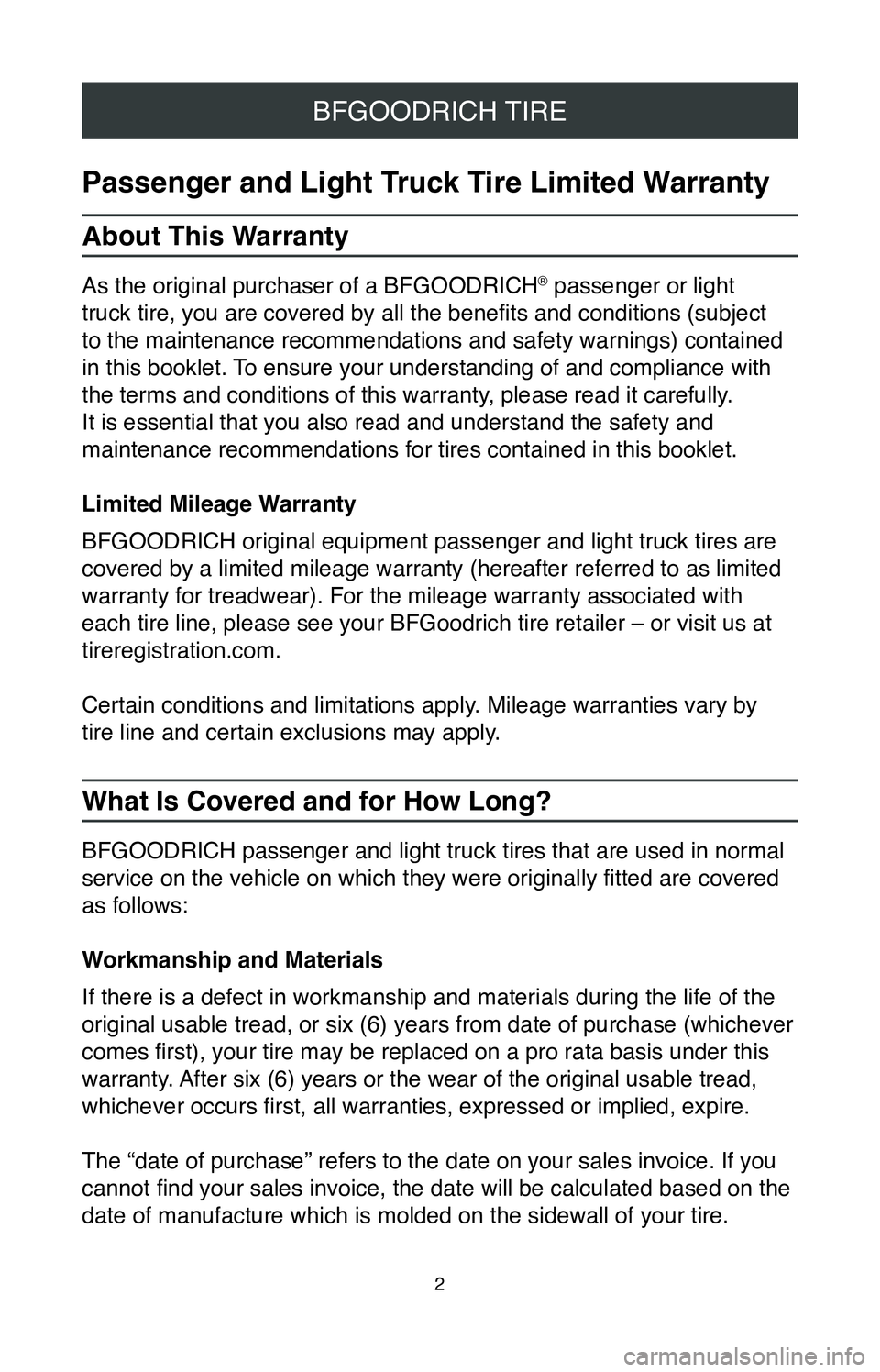
2
BFGOODRICH TIRE
Passenger and Light Truck Tire Limited Warranty
About This Warranty
As the original purchaser of a BFGOODRICH® passenger or light
truck tire, you are covered by all the benefits and conditions (subject
to the maintenance recommendations and safety warnings) contained
in this booklet. To ensure your understanding of and compliance with
the terms and conditions of this warranty, please read it carefully.
It is essential that you also read and understand the safety and
maintenance recommendations for tires contained in this booklet.
Limited Mileage Warranty
BFGOODRICH original equipment passenger and light truck tires are
covered by a limited mileage warranty (hereafter referred to as limited
warranty for treadwear). For the mileage warranty associated with
each tire line, please see your BFGoodrich tire retailer – or visit u\
s at
tireregistration.com.
Certain conditions and limitations apply. Mileage warranties vary by
tire line and certain exclusions may apply.
What Is Covered and for How Long?
BFGOODRICH passenger and light truck tires that are used in normal
service on the vehicle on which they were originally fitted are covered
as follows:
Workmanship and Materials
If there is a defect in workmanship and materials during the life of the\
original usable tread, or six (6) years from date of purchase (whichever
comes first), your tire may be replaced on a pro rata basis under this
warranty. After six (6) years or the wear of the original usable tread,
whichever occurs first, all warranties, expressed or implied, expire.
The “date of purchase” refers to the date on your sales invoice. I\
f you
cannot find your sales invoice, the date will be calculated based on the
date of manufacture which is molded on the sidewall of your tire.
Page 10 of 260
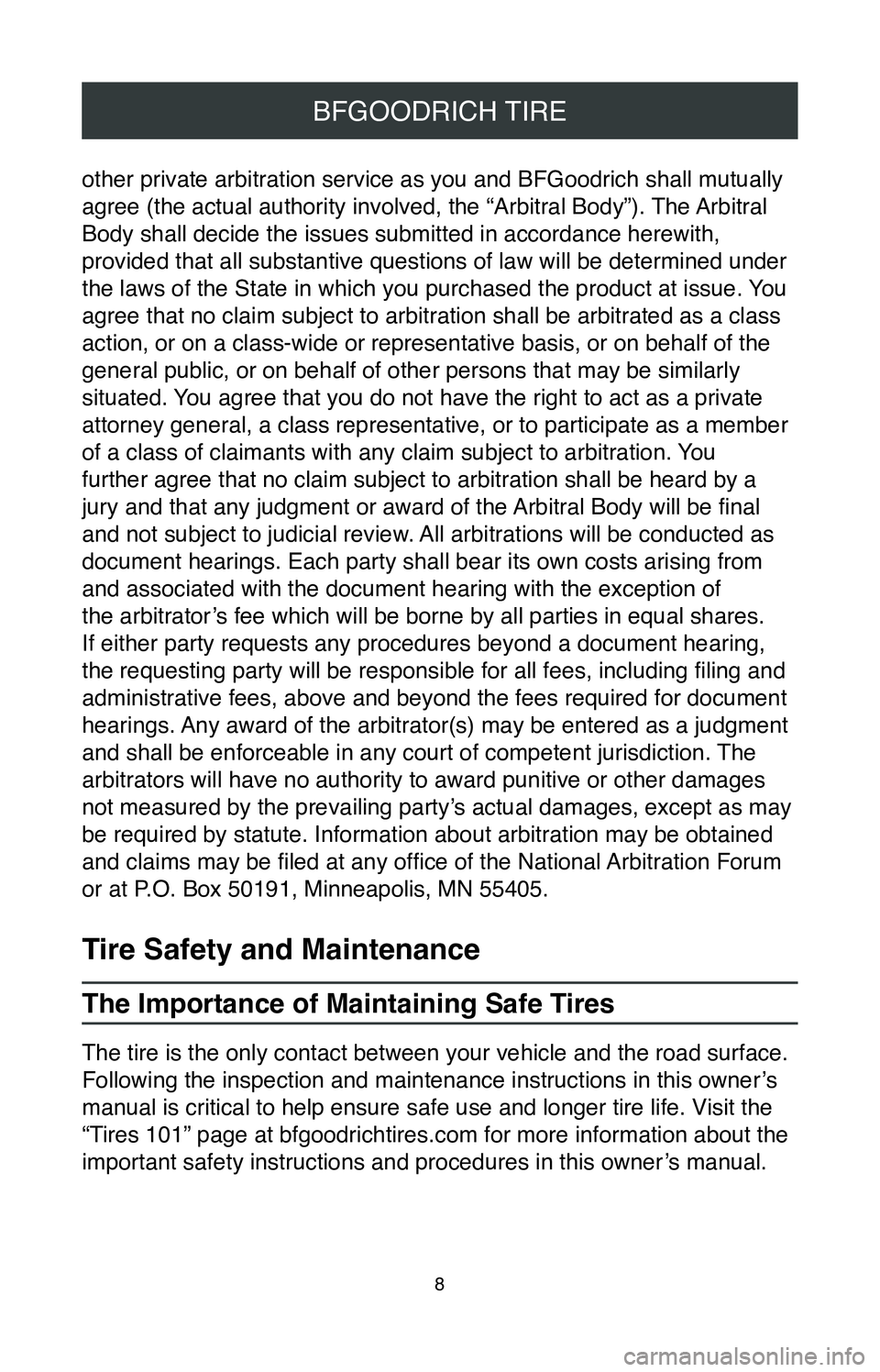
8
BFGOODRICH TIRE
other private arbitration service as you and BFGoodrich shall mutually
agree (the actual authority involved, the “Arbitral Body”). The Arbitral
Body shall decide the issues submitted in accordance herewith,
provided that all substantive questions of law will be determined under \
the laws of the State in which you purchased the product at issue. You
agree that no claim subject to arbitration shall be arbitrated as a class
action, or on a class-wide or representative basis, or on behalf of the
general public, or on behalf of other persons that may be similarly
situated. You agree that you do not have the right to act as a private
attorney general, a class representative, or to participate as a member \
of a class of claimants with any claim subject to arbitration. You
further agree that no claim subject to arbitration shall be heard by a
jury and that any judgment or award of the Arbitral Body will be final
and not subject to judicial review. All arbitrations will be conducted as
document hearings. Each party shall bear its own costs arising from
and associated with the document hearing with the exception of
the arbitrator’s fee which will be borne by all parties in equal shares.
If either party requests any procedures beyond a document hearing,
the requesting party will be responsible for all fees, including filing and
administrative fees, above and beyond the fees required for document
hearings. Any award of the arbitrator(s) may be entered as a judgment
and shall be enforceable in any court of competent jurisdiction. The
arbitrators will have no authority to award punitive or other damages
not measured by the prevailing party’s actual damages, except as may
be required by statute. Information about arbitration may be obtained
and claims may be filed at any office of the National Arbitration Forum
or at P.O. Box 50191, Minneapolis, MN 55405.
Tire Safety and Maintenance
The Importance of Maintaining Safe Tires
The tire is the only contact between your vehicle and the road surface. \
Following the inspection and maintenance instructions in this owner ’s
manual is critical to help ensure safe use and longer tire life. Visit the
“Tires 101” page at bfgoodrichtires.com for more information about the \
important safety instructions and procedures in this owner’s manual.
Page 11 of 260
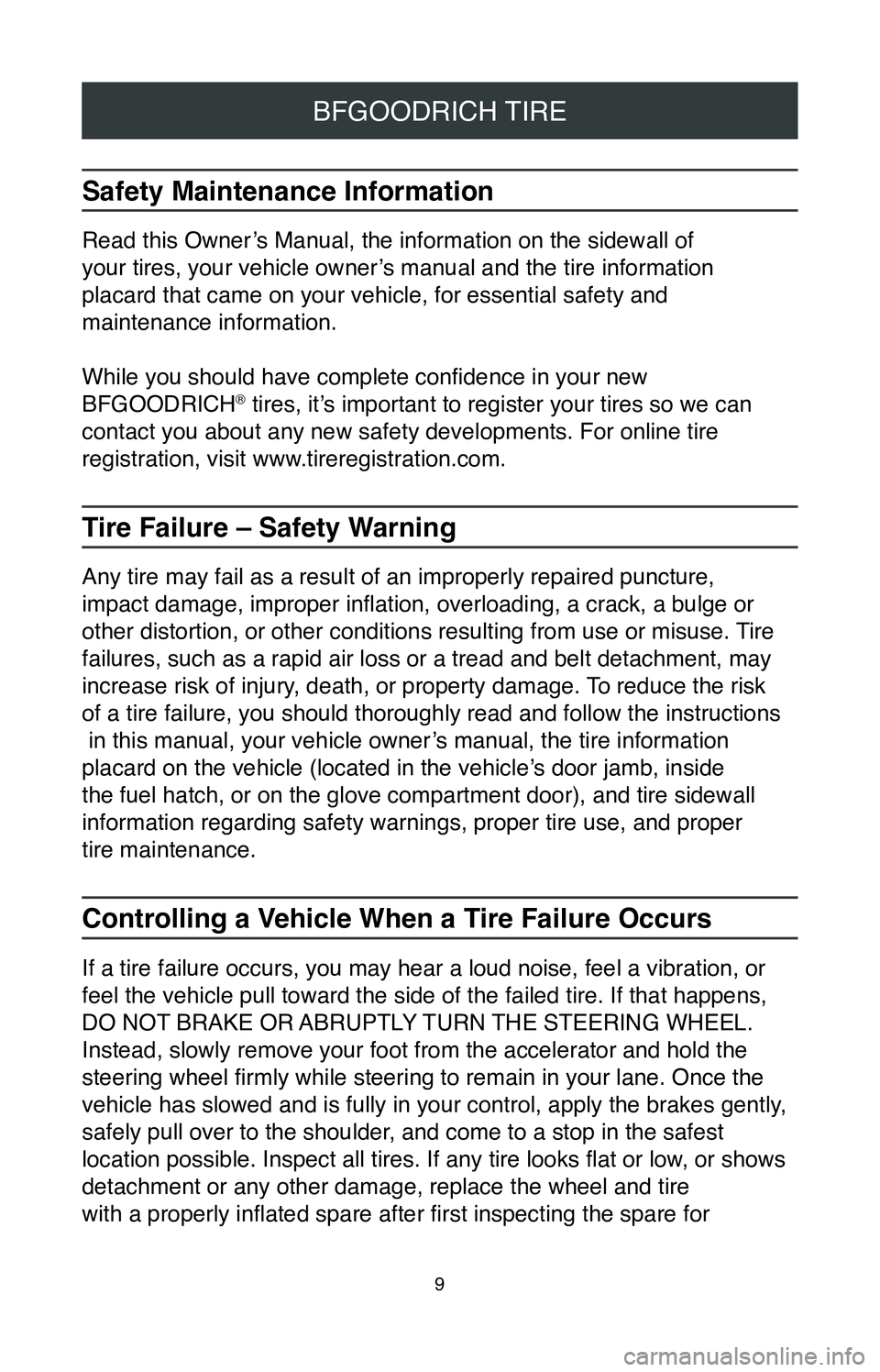
9
BFGOODRICH TIRE
Safety Maintenance Information
Read this Owner’s Manual, the information on the sidewall of
your tires, your vehicle owner’s manual and the tire information
placard that came on your vehicle, for essential safety and
maintenance information.
While you should have complete confidence in your new
BFGOODRICH
® tires, it’s important to register your tires so we can
contact you about any new safety developments. For online tire
registration, visit www.tireregistration.com.
Tire Failure – Safety Warning
Any tire may fail as a result of an improperly repaired puncture,
impact damage, improper inflation, overloading, a crack, a bulge or
other distortion, or other conditions resulting from use or misuse. Tire
failures, such as a rapid air loss or a tread and belt detachment, may
increase risk of injury, death, or property damage. To reduce the risk
of a tire failure, you should thoroughly read and follow the instruction\
s
in this manual, your vehicle owner’s manual, the tire information
placard on the vehicle (located in the vehicle’s door jamb, inside
the fuel hatch, or on the glove compartment door), and tire sidewall
information regarding safety warnings, proper tire use, and proper
tire maintenance.
Controlling a Vehicle When a Tire Failure Occurs
If a tire failure occurs, you may hear a loud noise, feel a vibration, o\
r
feel the vehicle pull toward the side of the failed tire. If that happen\
s,
DO NOT BRAKE OR ABRUPTLY TURN THE STEERING WHEEL.
Instead, slowly remove your foot from the accelerator and hold the
steering wheel firmly while steering to remain in your lane. Once the
vehicle has slowed and is fully in your control, apply the brakes gently\
,
safely pull over to the shoulder, and come to a stop in the safest
location possible. Inspect all tires. If any tire looks flat or low , or shows
detachment or any other damage, replace the wheel and tire
with a properly inflated spare after first inspecting the spare for
Page 27 of 260
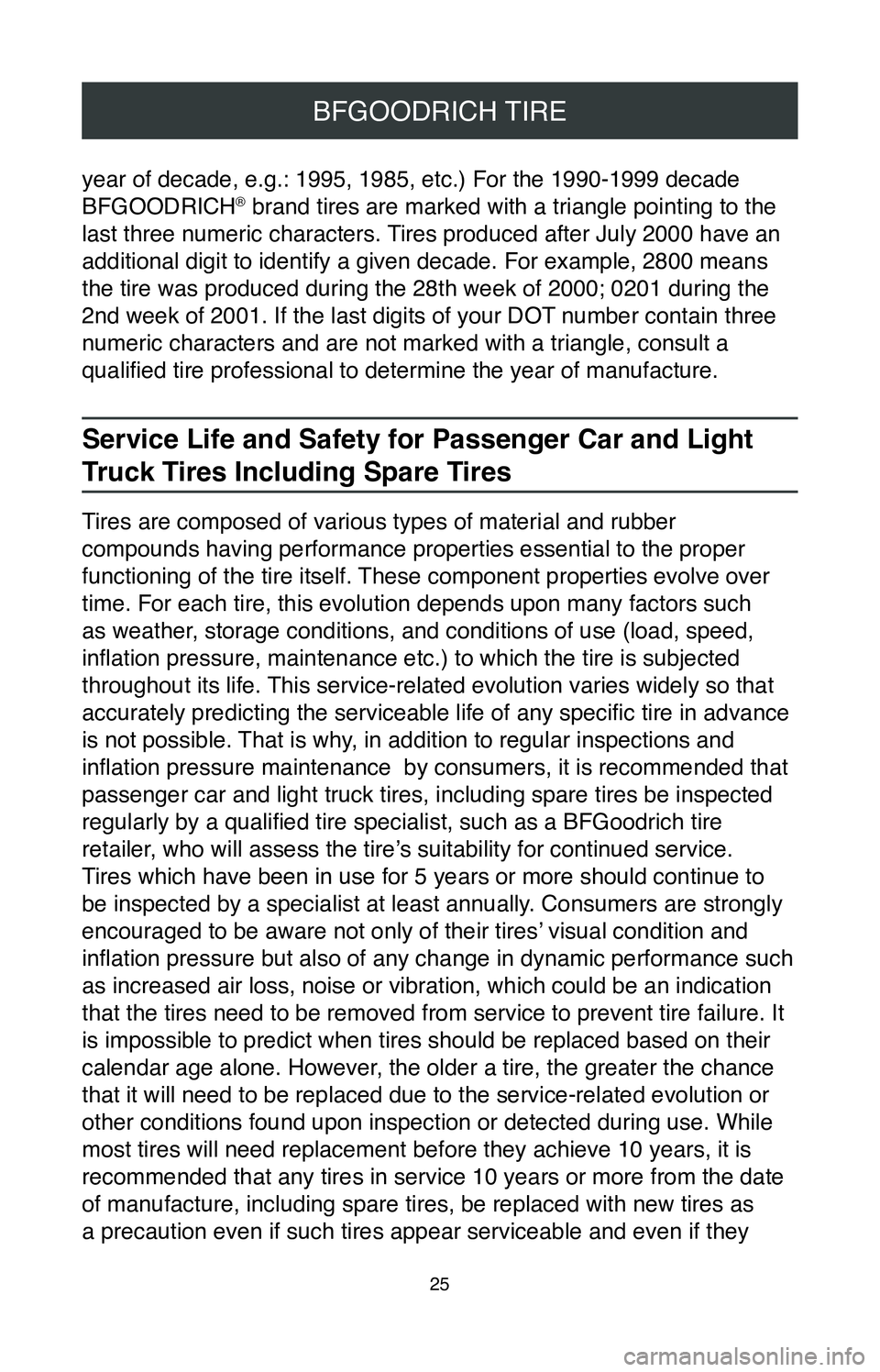
25
BFGOODRICH TIRE
year of decade, e.g.: 1995, 1985, etc.) For the 1990-1999 decade
BFGOODRICH® brand tires are marked with a triangle pointing to the
last three numeric characters. Tires produced after July 2000 have an
additional digit to identify a given decade. For example, 2800 means
the tire was produced during the 28th week of 2000; 0201 during the
2nd week of 2001. If the last digits of your DOT number contain three
numeric characters and are not marked with a triangle, consult a
qualified tire professional to determine the year of manufacture.
Service Life and Safety for Passenger Car and Light
Truck Tires Including Spare Tires
Tires are composed of various types of material and rubber
compounds having performance properties essential to the proper
functioning of the tire itself. These component properties evolve over
time. For each tire, this evolution depends upon many factors such
as weather, storage conditions, and conditions of use (load, speed,
inflation pressure, maintenance etc.) to which the tire is subjected
throughout its life. This service-related evolution varies widely so that
accurately predicting the serviceable life of any specific tire in advance
is not possible. That is why, in addition to regular inspections and
inflation pressure maintenance by consumers, it is recommended that
passenger car and light truck tires, including spare tires be inspected \
regularly by a qualified tire specialist, such as a BFGoodrich tire
retailer, who will assess the tire’s suitability for continued service.
Tires which have been in use for 5 years or more should continue to
be inspected by a specialist at least annually. Consumers are strongly
encouraged to be aware not only of their tires’ visual condition and
inflation pressure but also of any change in dynamic performance such
as increased air loss, noise or vibration, which could be an indication \
that the tires need to be removed from service to prevent tire failure. \
It
is impossible to predict when tires should be replaced based on their
calendar age alone. However, the older a tire, the greater the chance
that it will need to be replaced due to the service-related evolution or
other conditions found upon inspection or detected during use. While
most tires will need replacement before they achieve 10 years, it is
recommended that any tires in service 10 years or more from the date
of manufacture, including spare tires, be replaced with new tires as
a precaution even if such tires appear serviceable and even if they
Page 35 of 260
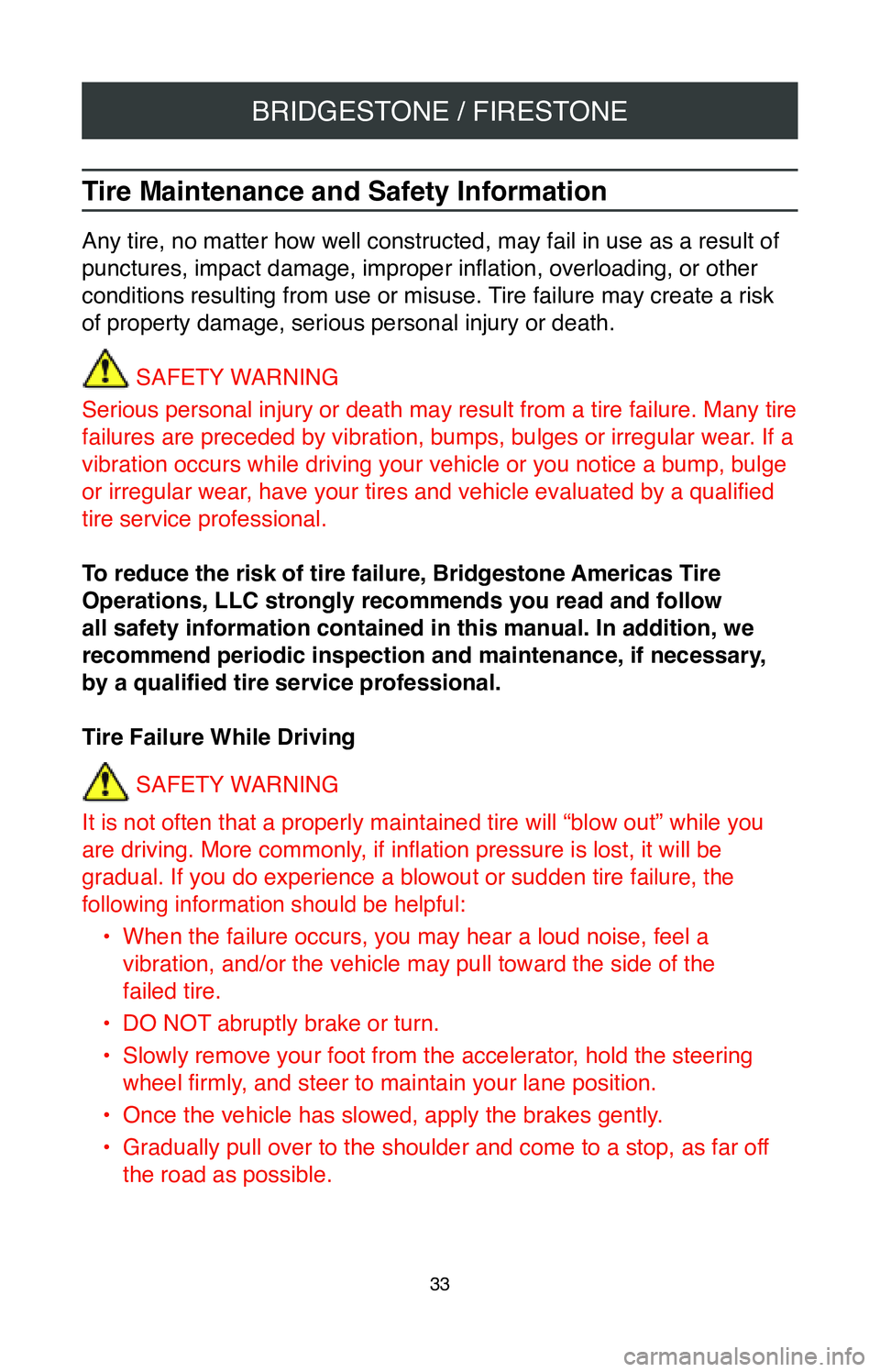
BRIDGESTONE / FIRESTONE
33
Tire Maintenance and Safety Information
Any tire, no matter how well constructed, may fail in use as a result of\
punctures, impact damage, improper inflation, overloading, or other
conditions resulting from use or misuse. Tire failure may create a risk
of property damage, serious personal injury or death.SAFETY WARNING
Serious personal injury or death may result from a tire failure. Many tire
failures are preceded by vibration, bumps, bulges or irregular wear. If a
vibration occurs while driving your vehicle or you notice a bump, bulge \
or irregular wear, have your tires and vehicle evaluated by a qualified
tire service professional.
To reduce the risk of tire failure, Bridgestone Americas Tire
Operations, LLC strongly recommends you read and follow
all safety information contained in this manual. In addition, we
recommend periodic inspection and maintenance, if necessary,
by a qualified tire service professional.
Tire Failure While Driving
SAFETY WARNING
It is not often that a properly maintained tire will “blow out” wh\
ile you
are driving. More commonly, if inflation pressure is lost, it will be
gradual. If you do experience a blowout or sudden tire
failure, the
following information should be helpful:
• When the failure occurs, you may hear a loud noise, feel a
vibration, and/or the vehicle may pull toward the side of the
failed tire.
•
DO NOT abruptly brake or turn.
•
Slowly remove your foot from the accelerator, hold the steering
wheel firmly, and steer to maintain your lane position.
•
Once the vehicle has slowed, apply the brakes gently.
•
Gradually pull over to the shoulder and come to a stop, as far off
the road as possible.
Page 39 of 260
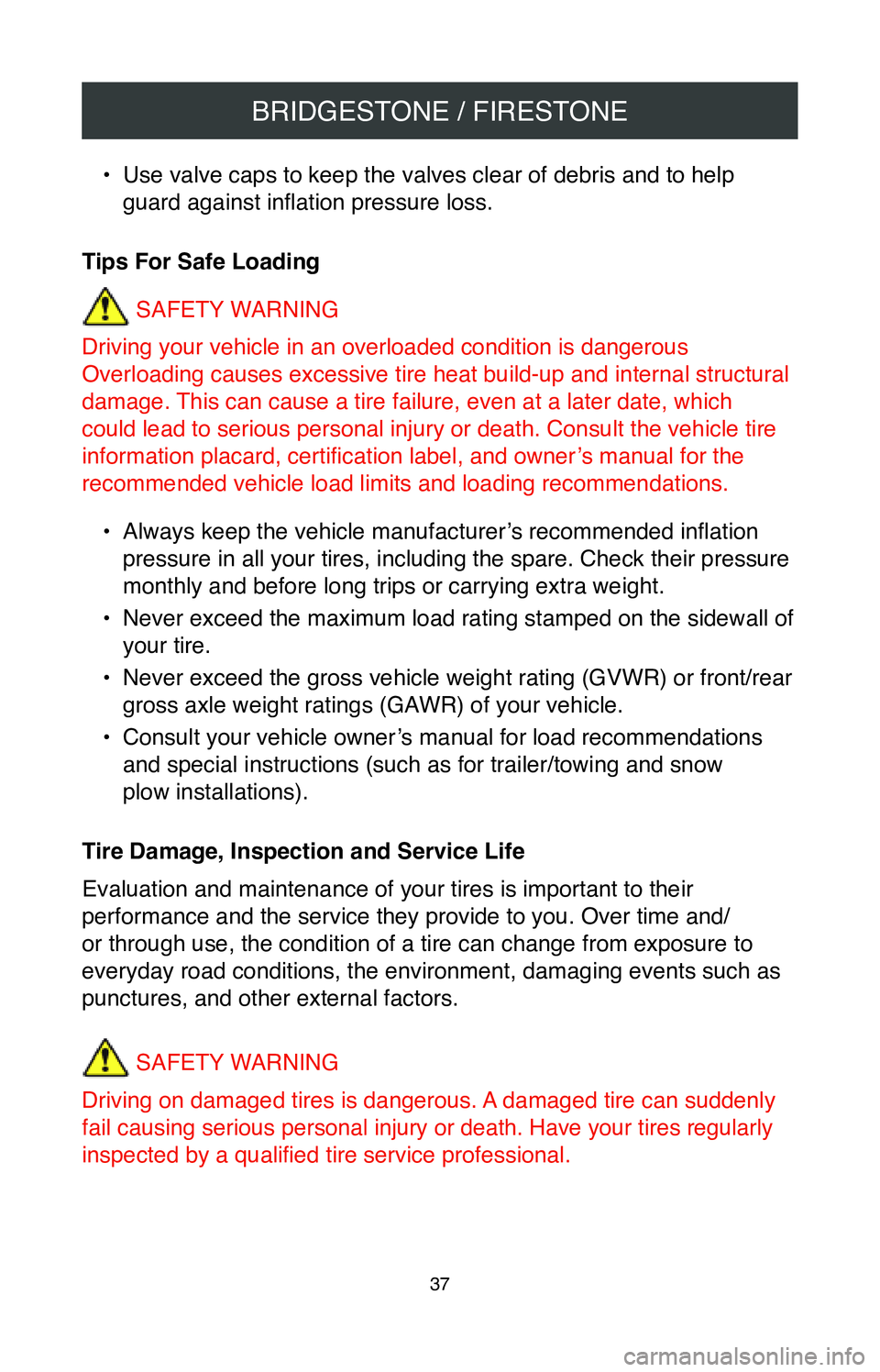
BRIDGESTONE / FIRESTONE
37
• Use valve caps to keep the valves clear of debris and to help
guard against inflation pressure loss.
Tips For Safe Loading SAFETY WARNING
Driving your vehicle in an overloaded condition is dangerous
Overloading causes excessive tire heat build-up and internal structural
damage. This can cause a tire failure, even at a later date, which
could lead to serious personal injury or death. Consult the vehicle tire
information placard, certification label, and owner’s manual for the
recommended vehicle load limits and loading recommendations.
•
Always keep the vehicle manufacturer’s recommended inflation
pressure in all your tires, including the spare. Check their pressure
monthly and before long trips or carrying extra weight.
•
Never exceed the maximum load rating stamped on the sidewall of
your tire.
•
Never exceed the gross vehicle weight rating (GVWR) or front/rear
gross axle weight ratings (GAWR) of your vehicle.
•
Consult your vehicle owner’s manual for load recommendations
and special instructions (such as for trailer/towing and snow
plow installations).
Tire Damage, Inspection and Service Life
Evaluation and maintenance of your tires is important to their
performance and the service they provide to you. Over time and/
or through use, the condition of a tire can change from exposure to
everyday road conditions, the environment, damaging events such as
punctures, and other external factors.
SAFETY WARNING
Driving on damaged tires is dangerous. A damaged tire can suddenly
fail causing serious
personal injury or death. Have your tires regularly
inspected by a qualified tire service professional.
Page 40 of 260
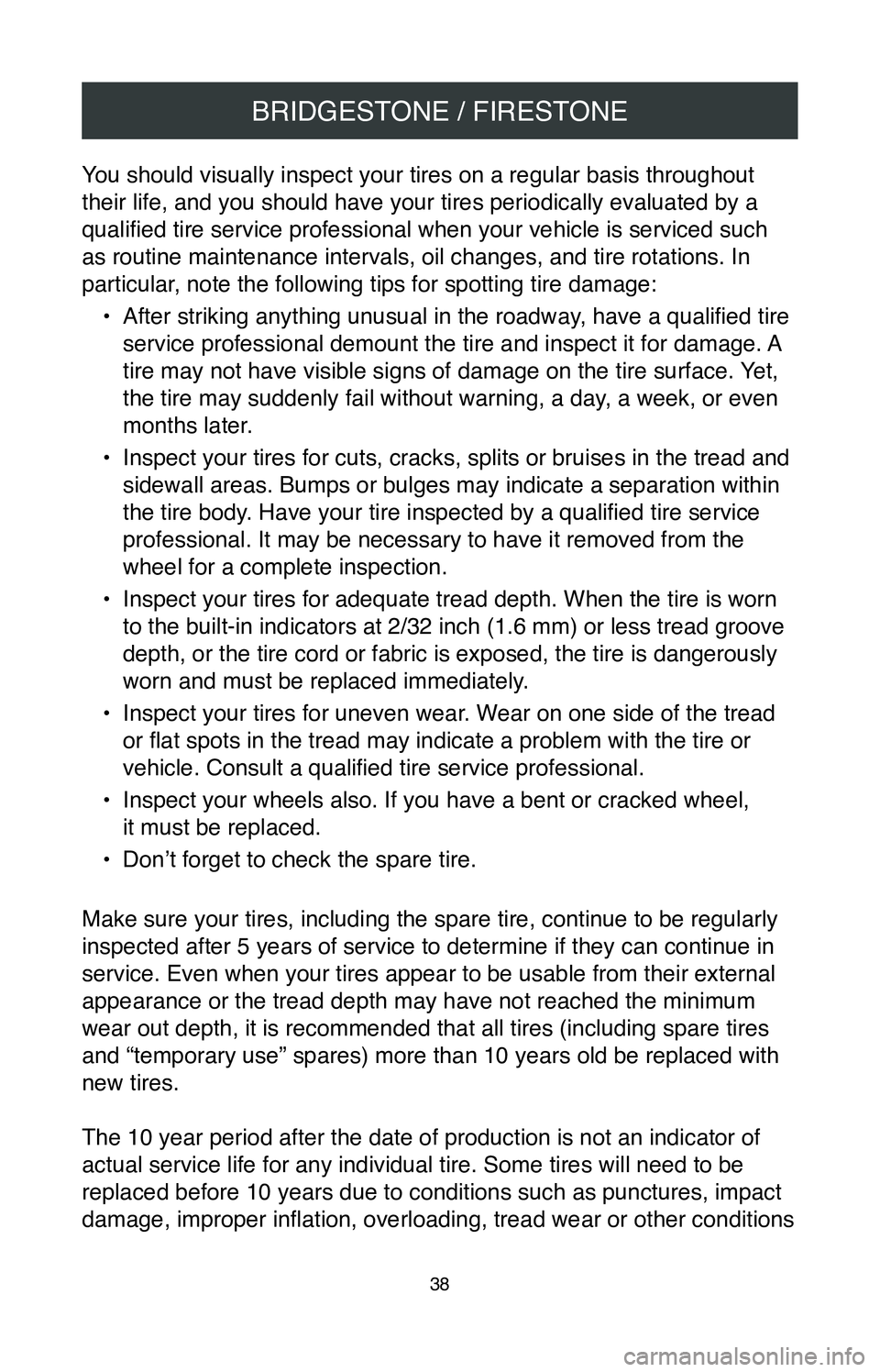
BRIDGESTONE / FIRESTONE
38
You should visually inspect your tires on a regular basis throughout
their life, and you should have your tires periodically evaluated by a
qualified tire service professional when your vehicle is serviced such
as routine maintenance intervals, oil changes, and tire rotations. In
particular, note the following tips for spotting tire damage:•
After striking anything unusual in the roadway, have a qualified tire
service professional demount the tire and inspect it for damage. A
tire may not have visible signs of damage on the tire surface. Yet,
the tire may suddenly fail without warning, a day, a week, or even
months later.
•
Inspect your tires for cuts, cracks, splits or bruises in the tread and \
sidewall areas. Bumps or bulges may indicate a separation within
the tire body. Have your tire inspected by a qualified tire service
professional. It may be necessary to have it removed from the
wheel for a complete inspection.
•
Inspect your tires for adequate tread depth. When the tire is worn
to the built-in indicators at 2/32 inch (1.6 mm) or less tread groove
depth, or the tire cord or fabric is exposed, the tire is dangerously
worn and must be replaced immediately.
•
Inspect your tires for uneven wear. Wear on one side of the tread
or flat spots in the tread may indicate a problem with the tire or
vehicle. Consult a qualified tire service professional.
•
Inspect your wheels also. If you have a bent or cracked wheel,
it must be replaced.
•
Don’t forget to check the spare tire.
Make sure your tires, including the spare tire, continue to be regularly\
inspected after 5 years of service to determine if they can continue in \
service. Even when your tires appear to be usable from their external
appearance or the tread depth may have not reached the minimum
wear out depth, it is recommended that all tires (including spare tires
and “temporary use” spares) more than 10 years old be replaced wi\
th
new tires.
The 10 year period after the date of production is not an indicator of
actual service life for any individual tire. Some tires will need to be \
replaced before 10 years due to conditions such as punctures, impact
damage, improper inflation, overloading, tread wear or other conditions
Page 52 of 260
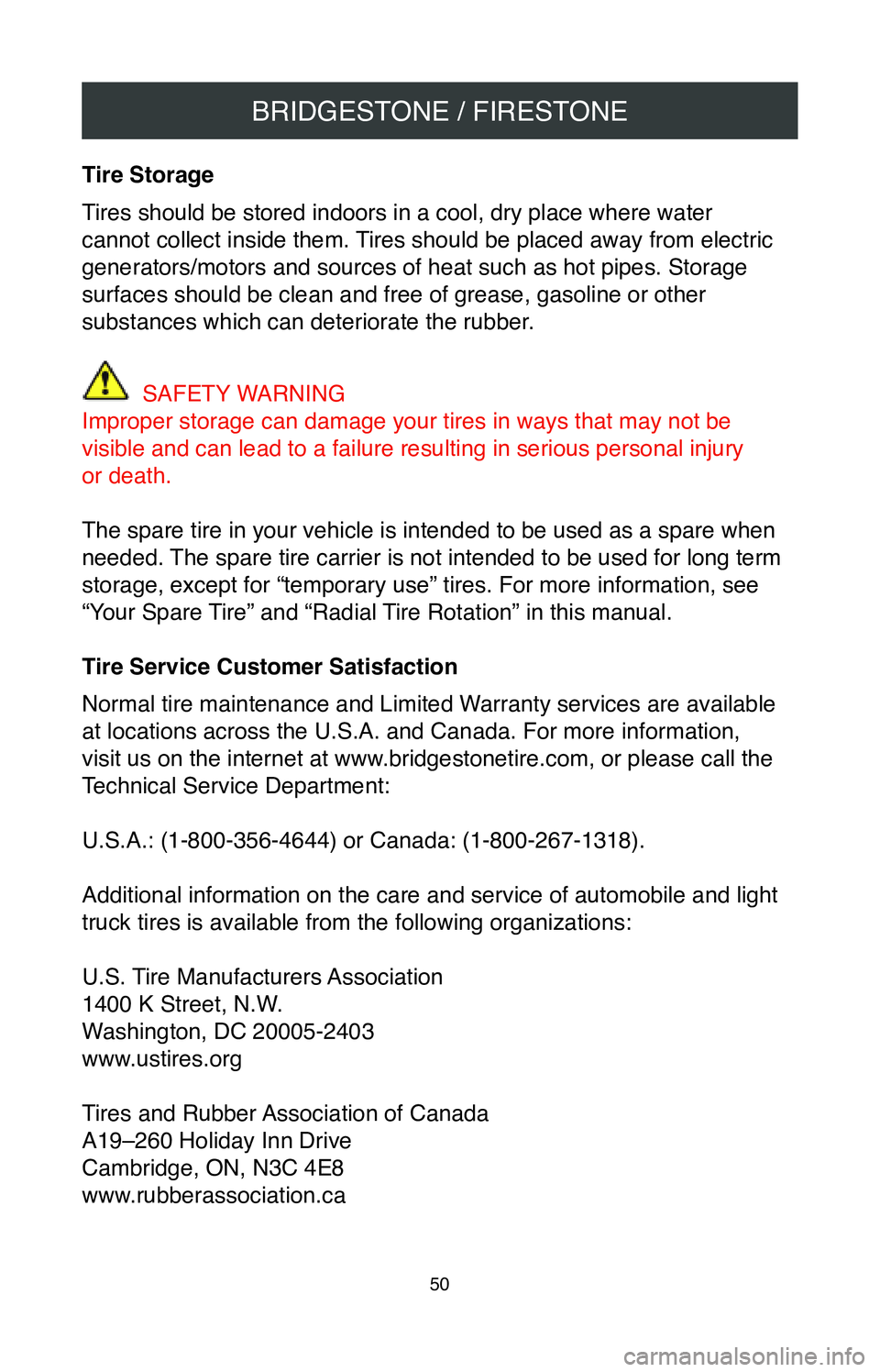
BRIDGESTONE / FIRESTONE
50
Tire Storage
Tires should be stored indoors in a cool, dry place where water
cannot collect inside them. Tires should be placed away from electric
generators/motors and sources of heat such as hot pipes. Storage
surfaces should be clean and free of grease, gasoline or other
substances which can deteriorate the rubber.
SAFETY WARNING
Improper storage can damage your tires in ways that may not be
visible and can lead to a failure resulting in serious personal injury
or death.
The spare tire in your vehicle is intended to be used as a spare when
needed. The spare tire carrier is not intended to be used for long term
storage, except for “temporary use” tires. For more information, s\
ee
“Your Spare Tire” and “Radial Tire Rotation” in this manual.
Tire Service Customer Satisfaction
Normal tire maintenance and Limited Warranty services are available
at locations across the U.S.A. and Canada. For more information,
visit us on the internet at www.bridgestonetire.com, or please call the
Technical Service Department:
U.S.A.: (1-800-356-4644) or Canada: (1-800-267-1318).
Additional information on the care and service of automobile and light
truck tires is available from the following organizations:
U.S. Tire Manufacturers Association
1400 K Street, N.W.
Washington, DC 20005-2403
www.ustires.org
Tires and Rubber Association of Canada
A19–260 Holiday Inn Drive
Cambridge, ON, N3C 4E8
www.rubberassociation.ca
Page 53 of 260
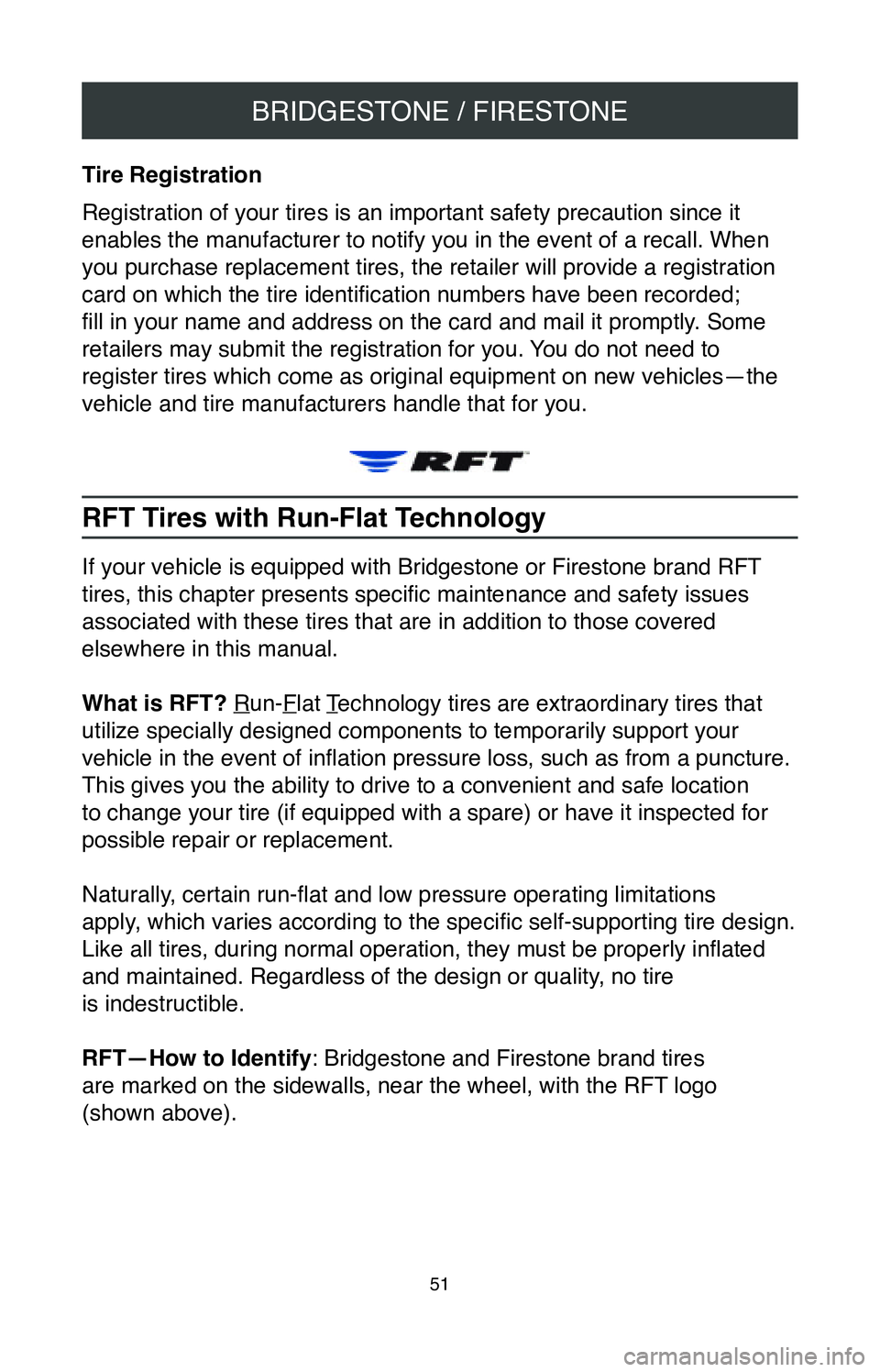
BRIDGESTONE / FIRESTONE
51
Tire Registration
Registration of your tires is an important safety precaution since it
enables the manufacturer to notify you in the event of a recall. When
you purchase replacement tires, the retailer will provide a registration\
card on which the tire identification numbers have been recorded;
fill in your name and address on the card and mail it promptly. Some
retailers may submit the registration for you. You do not need to
register tires which come as original equipment on new vehicles—the
vehicle and tire manufacturers handle that for you.
RFT Tires with Run-Flat Technology
If your vehicle is equipped with Bridgestone or Firestone brand RFT
tires, this chapter presents specific maintenance and safety issues
associated with these tires that are in addition to those covered
elsewhere in this manual.
What is RFT? Run-Flat Technology tires are extraordinary tires that
utilize specially designed components to temporarily support your
vehicle in the event of inflation pressure loss, such as from a puncture.
This gives you the ability to drive to a convenient and safe location
to change your tire (if equipped with a spare) or have it inspected for
possible repair or replacement.
Naturally, certain run-flat and low pressure operating limitations
apply, which varies according to the specific self-supporting tire design.
Like all tires, during normal operation, they must be properly inflated
and maintained. Regardless of the design or quality, no tire
is indestructible.
RFT—How to Identify : Bridgestone and Firestone brand tires
are marked on the sidewalls, near the wheel, with the RFT logo
(shown above).
Page 54 of 260
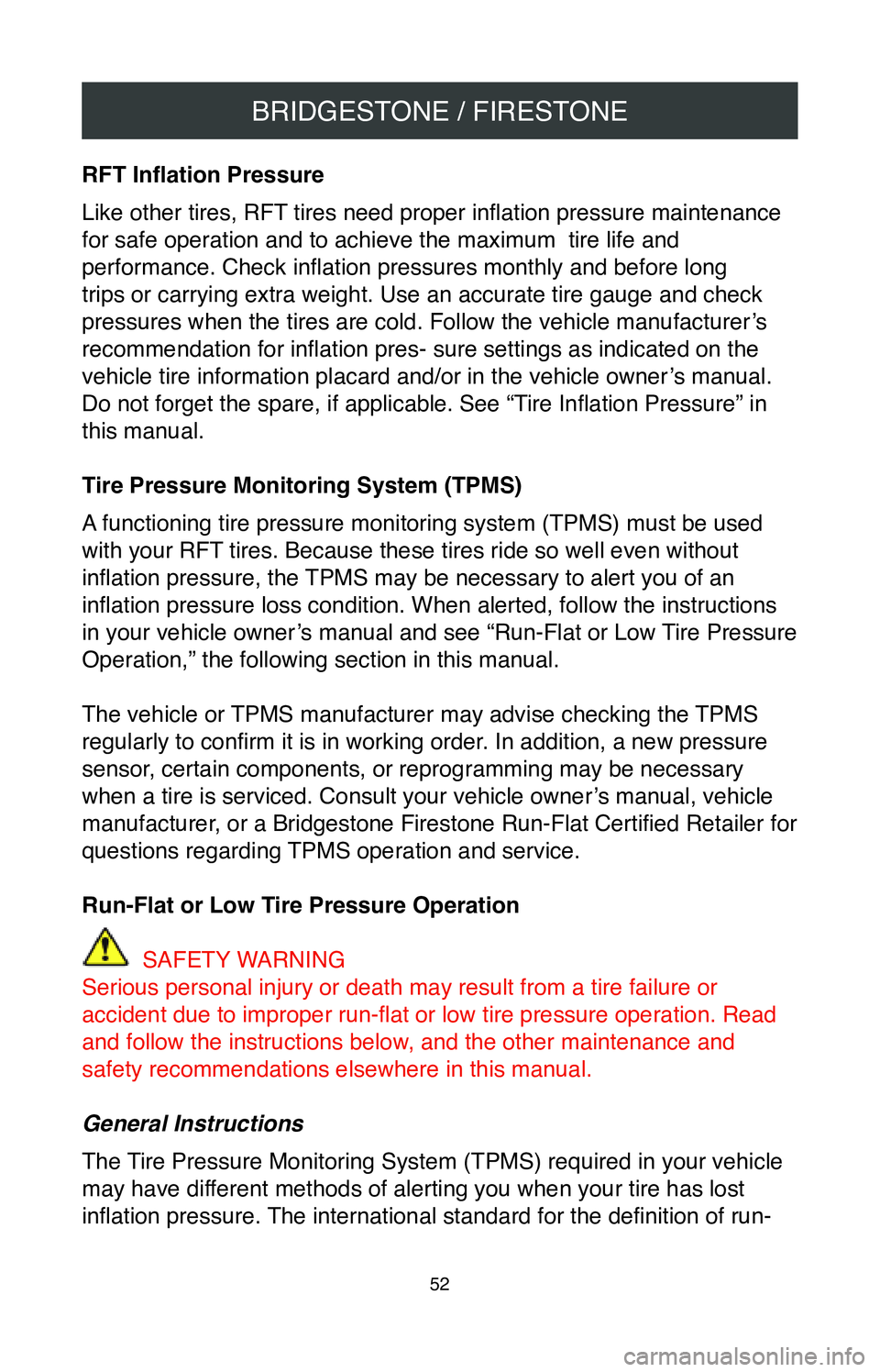
BRIDGESTONE / FIRESTONE
52
RFT Inflation Pressure
Like other tires, RFT tires need proper inflation pressure maintenance
for safe operation and to achieve the maximum tire life and
performance. Check inflation pressures monthly and before long
trips or carrying extra weight. Use an accurate tire gauge and check
pressures when the tires are cold. Follow the vehicle manufacturer’s
recommendation for inflation pres- sure settings as indicated on the
vehicle tire information placard and/or in the vehicle owner’s manual.
Do not forget the spare, if applicable. See “Tire Inflation Pressure” in
this manual.
Tire Pressure Monitoring System (TPMS)
A functioning tire pressure monitoring system (TPMS) must be used
with your RFT tires. Because these tires ride so well even without
inflation pressure, the TPMS may be necessary to alert you of an
inflation pressure loss condition. When alerted, follow the instructions
in your vehicle owner’s manual and see “Run-Flat or Low Tire Pressure
Operation,” the following section in this manual.
The vehicle or TPMS manufacturer may advise checking the TPMS
regularly to confirm it is in working order. In addition, a new pressure
sensor, certain components, or reprogramming may be necessary
when a tire is serviced. Consult your vehicle owner’s manual, vehicle
manufacturer, or a Bridgestone Firestone Run-Flat Certified Retailer for
questions regarding TPMS operation and service.
Run-Flat or Low Tire Pressure Operation
SAFETY WARNING
Serious personal injury or death may result from a tire failure or
accident due to improper run-flat or low tire pressure operation. Read
and follow the instructions below, and the other maintenance and
safety recommendations elsewhere in this manual.
General Instructions
The Tire Pressure Monitoring System (TPMS) required in your vehicle
may have different methods of alerting you when your tire has lost
inflation pressure. The international standard for the definition of run-